Introduction
Fresh and processed pork meat products are popular as an important source of animal protein and micronutrients including iron and group B vitamins (Górska-Horczyczak et al., 2017). According to Korean Ministry of Agriculture, Food, and Rural Affairs statistics, pork meat represents the highest domestic livestock product consumption in Korea at approximately 20.9 kg per capita in 2013. In particular, pork loin meats have been used to process smoked ham, sausage, cutlets, and Korean pork skewers owing to its low fat, uniform composition, and shape.
Raw pork meats are highly perishable food commodities owing to their biological composition (Leygonie et al., 2012). The shelf life of refrigerated meat product is limited because of high microbial growth and enzymatic activities. Therefore, freezing is an effective and widely applied preservation method to ensure the safety and quality retention of raw pork until their utilization in processing operations in food-production industries (Boonsumrej et al., 2007). However, frozen meats must be tempered prior to further processing (Taher and Farid, 2001) such as slicing or dicing (Bedane et al., 2017). For example, when frozen pork is used as the main raw material in cutlet manufacturing, it requires tempering before processing such as slicing, tenderizing, breading, and frying.
Frozen meat quality is closely related to the tempering conditions applied as well as fast freezing. Tempering generally occurs more slowly than freezing, and longer tempering times may promote microbial growth and increase partial temperature difference and energy consumption between the outside and the center of the meat block (Taher and Farid, 2001). In the ice-water phase transition, ice crystal formation disintegrates tissue membranes, resulting in moisture exudation during tempering (Choi et al., 2016). High drip loss decreases both weight and protein amounts significantly, resulting in pork meat product defects and poor consumer acceptance (Zang et al., 2017).
Conventional defrosting systems using cold and hot water, still-air, and low-velocity moving air environments have been applied in meat processing industries. However, each is associated with unique problems, including excessive time, high drip loss, surface temperature increase, and microbial growth on large-size meat surfaces (He et al., 2013). Thus, a tempering method is required that can maintain quality and avoid undesirable changes, while obtaining a fast tempering rate.
RF generates heat energy rapidly within food products through frictional interactions among polar dielectric molecules, which rotate in the space charge displacement in response to an externally applied AC electric field; this phenomenon is termed volumetric heating (Rincon and Singh, 2016). RF-assisted meat product tempering is reported for lean beef, pork, and shrimp (Choi et al., 2017), with 27.12 MHz RF being 85-fold faster than conventional air tempering for different meat blends (lean, lean/fat, and fat) (Farag et al., 2011). However, meat block tempering time and power absorption are affected by block size and shape and by the power intensity of the RF tempering system. The location, shape, and distance between RF plate electrodes are important factors contributing to RF-treated meat temperature uniformity (Uyar et al., 2014). Additionally, arcing and thermal runaway during processing result in local block surface and corner overheating (Rincon et al., 2015). Therefore, this study was performed to examine the effects of tempering using a newly developed RF tempering system (1000 and 1500 W) with a curved-electrode, forced-air convection (FC), and water immersion (WI) (4°C and 20°C) on the quality characteristics of cylindrically shaped-frozen pork loin.
Materials and Methods
Fresh pork loin (longissimus thoracis et lumborum) from 15 carcasses at 24 h post-mortem was purchased from a local market in Jeju, Republic of Korea. It was transported to the laboratory under refrigeration within 4 h. All visible fat and connective tissues were removed prior to experiments. Final weight of the refined cylindrical meat block (90-100 mm diameter and 300 mm in length) was approximately 1,500±200 g. Moisture, crude protein, crude fat, and ash contents were 69.76, 23.64, 3.67, and 1.22%, respectively, as measured according to AOAC (2007).
Aseptic linear low density polyethylene film-sealed pork meat samples were fully immersed and cryogenically frozen for 180 min in an immersion instant freezer (F-500, Top Greentech, Korea) equipped with a refrigerant maintained at −70±2°C containing 95% ethanol and 5% fluoride and a jet agitation regulator device. A specially designed stainless steel wire frame with apertures was used for meat sample location. The frozen samples were adjusted to the target initial temperature inside a freezer at −20°C for 72 h prior to tempering treatment.
Cylindrical frozen pork loin sample RF tempering was experimentally investigated using two 27.12 MHz RF systems in batch mode configuration. A curved-electrode RF system was developed with a 2-kW RF generator, 50-Ω automatic impedance matching network, and a controller set at 27.12 MHz constant frequency. This consisted of a metallic enclosure, generator, power amplifier, matching unit, and an RF applicator with a pair of flat (top) and semi-circular (bottom) electrodes. A semi-circular plastic board (∅ = 140 mm) was placed above the bottom electrode to avoid direct sample contact (Fig. 1). For comparison, the commercial parallel-electrode RF tempering system (FRT-5, Yamamoto Vinita, Japan) was used with a 5-kW RF generator, RF applicator with a pair of rectangular electrodes (750×500 mm), and a rectangular plastic board (800×600 mm) placed above the bottom electrode. Based on preliminary experiments and a previous study (Choi et al., 2017), the samples were sandwiched between the electrodes and tempered at 1000 or 1500 W for 5 and 10 min using a 130-mm electrode gap.
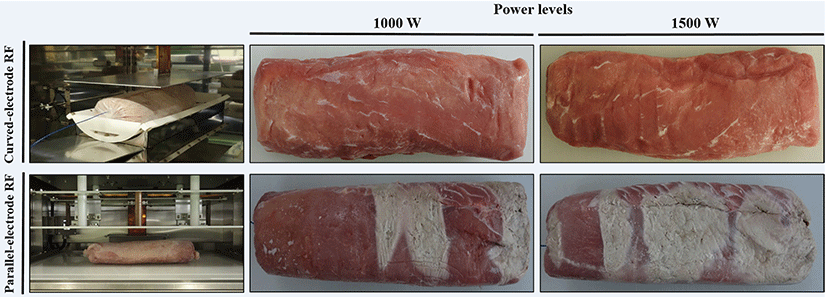
FC tempering was performed in a thermo-hygrostat system (SH-202M, Human Corporation, Korea) with controlled temperature (4 and 20±1°C) and humidity (90±5% relative humidity), and a 1.5 m/s measured air velocity as determined via anemometer (LM-8000A, Lutron Electronic Enterprise, Taiwan). WI tempering was performed by submerging the frozen pork samples in a water bath (VS-1205SW1, Vision Scientific, Korea) at 4°C and 20°C with forced agitation.
Frozen pork sample tempering time-temperature profiles were analyzed according to the method of Mousakhani-Ganjeh et al. (2015) with modification. To record the temperature changes during tempering, a fiber-optic temperature sensor (FOTEMP1-4, Optocon AG, Germany) was inserted at the geometric center of the cylindrical fresh pork block in the x, y, and z directions before cryogenic immersion freezing. The time required to raise the center temperature from −20°C to −2°C was determined as the tempering time. In this study, the endpoint temperature was set to approximately −2°C, which is typically used in the meat industry for tempered meat block handling and manipulation. Frozen pork sample tempering rate was calculated using Eq. (1).
Drip loss was determined by weighing the frozen and tempered pork samples before and after surface water removal according to Eq. (2).
For cooking loss, the methodology described by Kuttinarayanan and Ramanathan (2010) was followed. The tempered sample (10 g) was placed in a polyethylene bag and cooked at 80°C in a water bath for 25 min until the sample temperature reached 75°C. Cooking loss was determined using Eq. (3).
WHC was determined based on the method of Sánchez-Valencia et al. (2014). Tempered sample (3 g) was placed in an ultra-centrifugal filter tube (Ultracel-100K, Merck Millipore, Ireland). After boiling at 70°C for 30 min, the tube was centrifuged at 3,000 g and 4°C for 20 min. The meat pellets were carefully removed and then weighed. WHC was calculated using Eq. (4).
For pH, TBARS, and VBN value determination, tempered pork sample (10 g) was homogenized with 90 mL distilled water using a blender for 3 min. Sample pH was determined using a digital pH meter (Accumet AB 15; Fisher Scientific, USA) calibrated with fresh standard buffer solutions of pH 4.00, 7.00, and 10.00. The pH electrode was rinsed with distilled water between each measurement.
TBARS was determined as described by Ali et al. (2015). An aliquot of the homogenate (1 mL) was transferred into a disposable test tube and 2 mL of a 20 mM 2-thiobarbituric acid/15% trichloroacetic acid solution and 3 mL of 2% butylated hydroxytoluene were added. The mixture was vortexed and boiled in a water bath for 15 min, cooled at room temperature for 10 min, and centrifuged for 15 min at 2,000 g. The absorbance of the resulting supernatant solution was determined at 531 nm. TBARS values were calculated from a standard curve and expressed as milligrams of malonaldehyde per kilogram of sample (mg malonaldehyde/kg). The measurements were repeated in triplicate for each sample.
VBN was determined according to the method of Mousakhani-Ganjeh et al. (2015) with modification. The homogenate was filtered, and the filtrate was transferred to a Kjeldahl flask with 2 g of magnesium oxide and a few drops of Tween 80. The content of the Kjeldhal tube was distilled in 50 mL of 2% boric acid. Methyl red was used as an indicator. After titration of boric acid with 0.1 N HCl, the VBN concentration was calculated using Eq. (5).
To evaluate the tempering performance at the sample interior by various tempering methods, the samples were immediately bisected vertically and a thermo-graphic image was recorded with an infrared camera (A655sc, FLIR Systems, Germany) at an accuracy of ±2°C for one of the cut surfaces within 20 s to avoid a temperature increase.
The color of the sample surface was measured using a colorimeter (CR-300 Minolta Chroma Meter, Minolta Camera, Japan). Samples were placed on a white standard plate, and the Hunter values (L*, a*, and b*) were measured using a D65 illuminator at a standard observer angle of 10°. Color was measured at a minimum of 10 different locations across the surface of each sample. To compare the tempered samples with different initial color values of the fresh control, total color differences (ΔE*) were calculated using equation (Eq. (6)), where L0*, a0*, and b0* are the control color values.
Microstructure observation was performed as described by Anese et al. (2012) with some modifications. A 4-μm-thick section of formalin-fixed and paraffin-embedded sample was prepared using a microtome (Leica RM2255, Leica, Germany). Sections were stained with Harris hematoxylin and eosin Y alcoholic solution (BBC Biochemical, USA) using an autostainer (Tissue-Tek Prisma E2, Sakura Finetek USA, USA) prior to observation under a light microscope (Pannoramic MIDI, 3DHISTECH, Hungary). The intracellular spaces (irregular areas with white color) of the pork loin microstructure were analyzed using Digimizer image analysis software (version 4.6.1, MedCalc Software, Belgium).
To determine microbial counts after tempering, sample surface portions (25 g) were first mixed with 225 mL of peptone water (0.1% sterile peptone, w/v) in a sterile stomacher bag with a polyethylene filter layer, homogenized using a stomacher (MIX 2; AES Laboratoire, France) for 3 min, and diluted with peptone water to determine the microbial count. Serial dilutions were performed in triplicate. For total aerobic bacteria counts, the diluted samples (1 mL) were plated onto 3M Petrifilm Aerobic Count Plates (Petrifilm AC; 3M, USA). Coliforms were plated onto 3M Petrifilm Escherichia coli/Coliform Count Plates (Petrifilm EC; 3M, USA). Both plates were incubated at 37°C for 48 h and 24 h, respectively. Yeast and molds counts were determined by plating the diluted samples (l mL) onto 3M Petrifilm Yeast and Molds Count Plates (Petrifilm YM; 3M, USA). The yeast and molds plates were incubated at 25°C for 72 h. Microbial counts (expressed as Log CFU/g) were performed in triplicate.
Analysis of variance and Duncan’s multiple range tests were performed on the data using Statistical Package for the Social Sciences software version 19 (SPSS, USA). All results are expressed as the means±standard deviation, and differences at p<0.05 were considered statistically significant.
Results and Discussion
The time-temperature profiles of cylindrical frozen pork loin meats measured at the center of the samples using different electrode shaped-RF tempering systems are shown in Fig. 2. At the beginning of the tempering process, sample temperatures rose quickly. Once temperature increased to approximately −5°C, the ice crystals started to melt and the tempering rate decreased. This could be due to the approximately 3-fold higher thermal conductivity of ice (1.6 W/m K) compared to water (0.6 W/m K) at 20°C. Temperatures increased faster with curved-electrode RF. After parallel-plate RF tempering at 1,000 W for 10 min and 1,500 W for 5 min, respectively, the temperature of the center of the cylindrical frozen pork sample did not reach −2°C (Fig. 2). We recently demonstrated that the internal thermal distribution in the parallel-plate RF tempering at 200-400 W was very uniform, which prevents overheating of the edges of the frozen rectangular pork blocks (Choi et al., 2017). However, cylindrical sample surface and edge overheating occurred with the parallel-plate RF system (Fig. 1), although the sample center remained frozen, presumably owing to increased electric field distribution resulting from deflection at surfaces and edges.
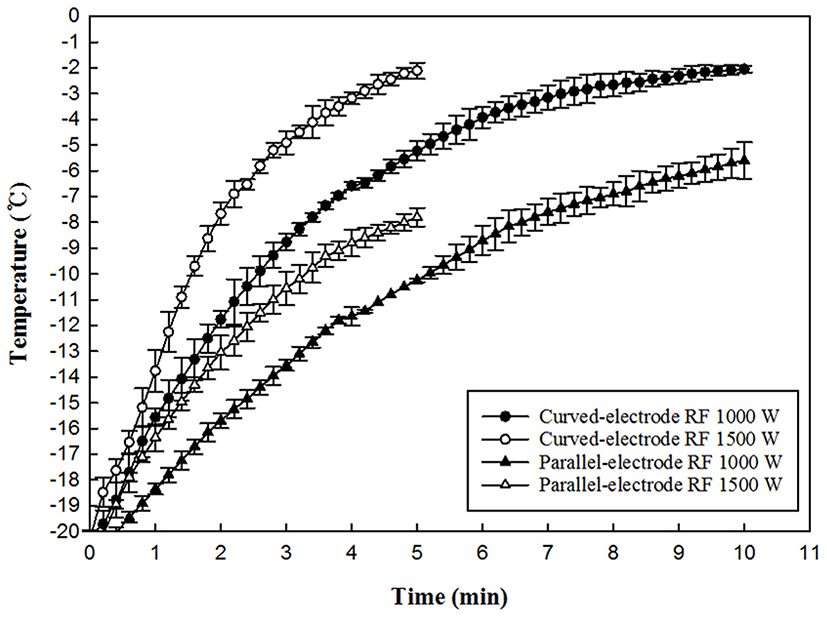
Guan et al. (2015) reported that food shape and size interact with the electromagnetic field displacement, determining the distribution of volumetric power rate and therefore temperature distribution. Power transfer efficiency is also determined by electrode system configuration (Laycock et al., 2003). At 27.12 MHz, RF-assisted tempering is thus more suitable for thicker meat products as the dielectric properties of meat result in higher penetration depth compared to 2450 or 915 MHz microwave tempering. To obtain an acceptable tempering uniformity, a curved-electrode RF tempering system was designed to prevent higher temperatures on cylindrical frozen pork loin surfaces and corners, and consecutive experiments were performed for comparison with traditional tempering methods such as FC and WI.
Fig. 3 shows the temperature changes over time of the frozen samples subjected to FC and WI tempering conditions. FC tempering at 4°C exhibited the longest time (815 min), followed by FC at 20°C, and WI at 4°C and 20°C (85-250 min). Notably, FC tempering and refrigeration temperature resulted in a low heat transfer rate and long tempering time. However, after 10 and 5 min of curvedelectrode RF tempering, sample center temperatures increased to approximately −2°C, corresponding to an approximately 163-fold decrease in tempering time of RF-1500 W compared to FC at 4°C. These results are similar to those of Farag et al. (2009), which found that conventional air defrosting of lean beef meat was up to 21 times slower than the 27.12-MHz RF method. Curved-electrode RF tempering achieved a power intensity-dependent faster rate, with 1000 and 1500 W RF corresponding to 2.04 and 4.18°C/min, respectively, in contrast to 0.03-0.11°C/min for FC and WI tempering at 4 and 20°C (Table 1). Comparatively, Farag et al. (2008) reported tempering time differences of a beef meat block (4 kg) from an initial temperature of −20°C by RF tempering when varying the power from 400-600 W.
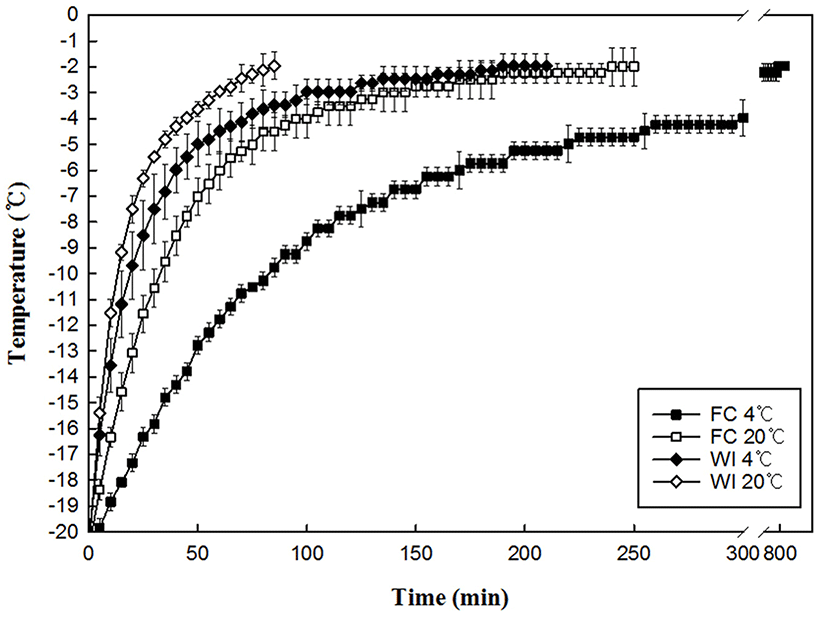
1Mean values in the same row (a-d) followed by different letters are significantly different according to Duncan's multiple range test (p<0.05). FC, forced-air convection; WI, water immersion; RF, radio frequency.
The drip loss of the samples tempered with WI at 20°C showed the highest value (6.33%) among all methods tested. Compared to FC tempering, curved-electrode RF tempering exhibited relatively low drip loss, with an approximate 1.42-1.98% difference (Table 1). These results are similar to those previously reported (Xia et al., 2012), wherein porcine longissimus muscle drip loss from WI (14°C) lotic water (9°C) tempering methods were significantly higher than from refrigeration (4°C). Leygonie et al. (2012) reported that increased tempering rates result in less exudate formation. Our findings also agree with those of Farag et al. (2009), wherein 27.12 MHz RF thawing significantly reduced lean beef drip loss compared to conventional air thawing.
Control cooking loss was 28.03%, significantly lower than that of most tempering treatments (31.67-33.50%) except WI at 20°C, with negligible difference between treatments (Table 1). Cooking loss appears not to differ significantly with fresh/frozen status or freezing/defrosting rate (Vieira et al., 2009), although He et al. (2013) reported a 30.0-32.6% cooking loss in pork tenderloin tempered with high-voltage electrostatic field. This inter-study variation in pork meat cooking loss may be explained by differences in samples, tempering rates, and tempering end temperatures applied.
Compared to the control, WHCs of tempered frozen pork samples were significantly (p<0.05) lower. FC tempering at 20°C showed the lowest WHC (57.86%). A decrease in WHC can cause meat products to be judged unacceptable because of nutrient loss, which is of considerable importance to consumers (Lan et al., 2016). Meat WHC depends on myofibrillar protein structure, particularly of myosin (Ali et al., 2015). Changes in ionic strength, pH, or oxidation of meats (by freezing and tempering) directly affect myofibrillar protein and muscle cell efficiency in entrapping and binding water (Huff-Lonergan and Lonergan, 2005).
In the present study, no significant changes in the pH of fresh and tempered cylindrical pork loin samples were observed (Table 2). The pH of the control was 5.90. Similarly, a previous study (Ali et al., 2015) showed that chicken breast pH remains unchanged during five freeze-thaw cycles.
The effect of tempering conditions on protein and lipid oxidation of frozen pork loin samples is shown in Table 2. At 12.08 mg N/100 g, the control VBN is within the generally acceptable range of fresh pork loin (He et al., 2013). Following WI tempering at 20°C, the sample VBN was 13.39 mg N/100 g, significantly (p<0.05) higher than in other tempering methods. Ali et al. (2015) and Xia et al. (2009) reported that the changes in meat redness and yellowness could be related to metmyoglobin formation as an indication of protein oxidation. The VBN value is thus an important indicator of meat decay, and 20 mg N/100 g meat muscle was proposed as the highest acceptable level (Lin et al., 2013). In the present study, the VBN value was below this value in all samples, indicating that a high standard of freshness was met with these methods.
1Mean values in the same row (a-c) followed by different letters are significantly different according to Duncan's multiple range test (p<0.05).
VBN, volatile base nitrogen; TBARS, thiobarbituric acid reactive substance; FC, forced-air convection; WI, water immersion; RF, radio frequency.
Samples treated with the six tempering methods differed insignificantly from the control TBARS value of 0.04 mg malonaldehyde/kg. As lipid oxidation products react with nitrogenous materials in biological systems, such as proteins, amino acids, and phospholipids, to form brown pigments and fluorescent compounds (Kubow, 1992), and reactions with MDA and protein derivatives form carbonyls such as ketones and aldehydes, leading to decreased beef tenderness (Rowe et al., 2004), these data suggest that the curved-electrode RF tempering technology used in this study likely did not affect protein and lipid oxidation in the cylindrical frozen pork loin samples during the tempering process.
The temperature distributions at the top, middle, and bottom within the 1,000 and 1,500 W RF-tempered samples were relatively uniform compared to those of the other tempering treatments (Fig. 3), resulting in more cold spots at approximately −2°C. Llave et al. (2014) showed a similar uniform temperature distribution by RF tempering of frozen tuna blocks. The irregular temperature distributions of FC or WI tempering treatments can be attributed to heat conductivity and diffusivity, resulting in relatively higher exterior than center sample temperatures. As FC or WI tempering operates from surface to interior, more time is required (Wen et al., 2015). Therefore, the deeper penetration ability combined with more uniform field patterns indicate that RF tempering is a more efficient method overall.
Pork meat color changes constitute the most important and direct attributes for evaluating visual quality (O’Sullivan et al., 2003). The tempering protocol effects on sample instrumental color properties are shown in Table 3. The L* values for the curved-electrode RF, FC, and WI tempering treatments did not differ from that of the control.
1Mean values in the same row (a-c) followed by different letters are significantly different according to Duncan's multiple range test (p<0.05). FC, forced-air convection; WI, water immersion; RF, radio frequency.
FC and WI tempering considerably decreased sample a* values, presumably related to myoglobin denaturation (Lien et al., 2002). Neither a* nor b* values were significantly altered under curved-electrode RF tempering conditions, whereas WI tempering markedly decreased b* values.
For samples tempered with curved-electrode RF, FC, and 4°C WI, the total color difference (ΔE*) value between the control and other tempering treatments ranged from 2.33 to 3.27, with 20°C WI giving the highest ΔE* value (5.10). Meat color depends on factors such as pigment protein and myoglobin concentration, moisture content, and WHC (Farouk and Swan, 1998; Ibanez et al., 1995). Additionally, changes in meat yellowness and redness may occur owing to metmyoglobin formation and exudate production including myoglobin, indicating the contribution of protein oxidation to color changes during tempering processing (Llave et al., 2014). These findings support the changes in quality characteristics revealed from drip loss, WHC, and VBN data (Table 1 and 2).
Histological images of fresh and tempered pork loin tissue are shown in Fig. 4. The control (fresh meat) tissue showed transverse sections of relatively homogeneous myofibrils that maintained their integrity. In contrast, tissue damage during the freezing and defrosting processes was the inevitable result of intra- and extracellular ice crystal formation. Extracellular ice crystals are responsible for intense tissue damage, accounting for a high drip loss (Anese et al., 2012). During FC tempering, muscle fibers were ruptured and the cavity between the muscle fibers increased. Additionally, greater vacuolization, formed from ice crystals, was observed within the muscle fibers after FC and WI tempering compared to that observed following curved-electrode RF. The intracellular space number in FC or WI-tempered samples increased significantly (p<0.05) compared with that of curved-electrode RF (Table 4). Compared to FC tempering at 4°C, the pork loin microstructures subjected to curved-electrode RF tempering at 1,000 and 1,500 W exhibited relatively smaller intracellular space areas, with 218.47 and 200.31 μm2 differences, respectively (Table 4). RF tempering maintained myofibril conditions, although their density was less than that of the control. White space size and number in muscle cells is an index of muscle deterioration, because the formation of large spaces should lead to extensive mechanical damage (Jia et al., 2017). An improper defrosting process could result in structural damage, protein denaturation, and abnormal cell distribution of meat products (Xia et al., 2012). Based on the present evaluations, RF dielectric heating technology for frozen meat products appears to be an effective alternative to conventional, time-consuming tempering methods, which can reduce meat quality.
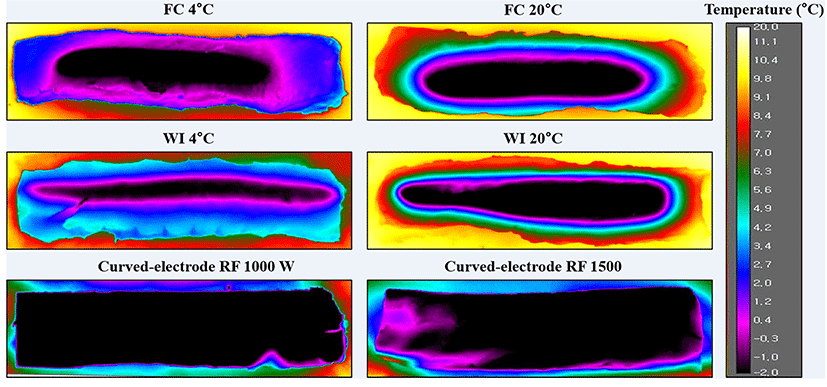
1Mean values in the same row (a-c) followed by different letters are significantly different according to Duncan's multiple range test (p<0.05). FC, forced-air convection; WI, water immersion; RF, radio frequency.
One of the most important factors affecting hygiene status and microbiological quality of raw meat products is the counts of pre-existing microorganisms that grow in meat (Engel et al., 1990). Table 5 shows the changes in microbial counts of fresh and frozen pork loin samples after six tempering treatments. The counts of total aerobic bacteria, coliforms, and yeast and molds in the control were 3.35, 1.68, and 3.95 Log CFU/g, respectively.
1Mean values in the same row (a-e) followed by different letters are significantly different according to Duncan's multiple range test (p<0.05).
2N/D: Not detected (<1 Log CFU/g). FC, forced-air convection; WI, water immersion; RF, radio frequency.
Counts of total aerobic bacteria were noticeably (<1 Log CFU/g) reduced compared to the control following 4°C FC or 1,000 and 1,500 W curved-electrode RF tempering, coupled with cryogenic immersion freezing. In contrast, total aerobic bacteria counts in samples subjected to WI tempering at 20°C increased by 4.07 Log CFU/g.
Similar effects were observed for coliform counts (Table 5), which were not detected after most treatments except FC and WI at 20°C. Alternatively, in all samples, yeast and mold counts were 3.82-4.13 Log CFU/g, indicating no significant (p>0.05) differences among fresh and tempered pork loin meats.
The bactericidal effect of the combined freezing and tempering processes on microorganisms in meats occurs as a result of bacterial cell membrane disruption by exposure to concentrated extracellular fluid or dehydration by osmotic pressure (Sriket et al., 2007). Conversely, moisture lost during long-duration tempering provides a nutrient-rich medium for microbial reactivation or growth (Leygonie et al., 2012). Defrosting meat products under cold running water is often recommended; however, unless the meat product is covered by packaging materials, microbial contaminants and purge will overflow into the sink area, increasing the potential for cross-contamination (Beauchamp et al., 2010).
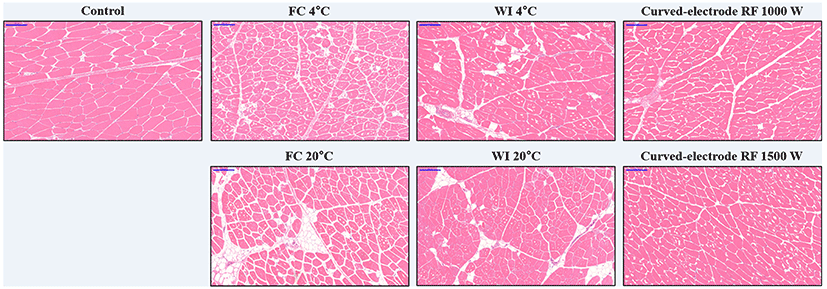
Conclusions
In the present investigation, we showed that RF tempering with newly designed curved-electrode plates is an effective technology for reducing the tempering time of cylindrical frozen pork loin meat in comparison to conventional FC or WI tempering. Curved-electrode RF tempering showed better drip loss results compared to FC and WI. Furthermore, curved-electrode RF tempering showed an uniform thermal distribution, allowing cylindrical frozen pork loin meat to be processed in a more homogeneous manner. Therefore, for practical applications, curved-electrode RF tempering is potentially advantageous in achieving shorter tempering time, smaller processing space, and quality maintenance for cylindrical-shaped meat blocks in the meat processing industry.













